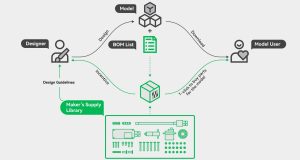Chris Elsworthy, CEO of CEL and creator of the Robox 3D printer
If there’s one industry which loves operating at the cutting edge, it’s dentistry. Most dentists adore their gadgets and love using the latest advances in technology to improve their clinical practice and enhance their competitive edge. This doesn’t just mean shiny new surgical instruments – it also means cinema viewing goggles to wear during surgery or new, and high tech appointment booking software. The boundaries are always being pushed as dentists enjoy finding the next big way to differentiate themselves from the rest of the pack.
So what will the world’s tech-savvy dentists be getting their teeth into next? One of the big areas set for expansion is in-surgery 3D printing, with small to medium sized 3D printers poised to pop-up on dentist desks and in reception rooms in the near future.
3D printing technology is now beginning to be used in an innovative way to help make implant surgery procedures much more efficient. Implant surgery takes place when patients require an entire tooth, or set of teeth, to be surgically implanted into their jaw. This creates a much longer lasting and patient-friendly alternative to more basic measures such as dentures which require some sort of adhesive. It does, however, mean that the dentist must drill into the patient’s jaw to set the implant.
You might be surprised to learn that currently around the world, over 98% of these surgeries are carried out freehand, with the dentist looking at scans and working out by eye where they should place their drill. There is no guarantee that that the implants will always be in the right position, which can lead to increased recovery times, longer operations, and in some cases having to abort the surgery and wait for the patient to heal before trying again. This is costly both in terms of time and money for both the patient and the dentist.
Fortunately, a growing number of dentists, led by Florida’s Dr Rick Ferguson and his Implant Educators programme, are now using 3D printed bespoke drilling guides. These guides are created to perfectly fit the patient’s mouth, slotting in exactly around their jaw and existing teeth and providing a hole in the right position and at the right angle for the perfect placement of the drill. This is much easier for the dentist – because the guide is created using scans of the patient and calculated for optimum placement, so the dentist can simply slot in a guide and start drilling, greatly reducing the length of time the surgery takes.
You’re probably asking then why this hasn’t always been the industry standard when it has so many benefits for dentists and their patients? The answer of course lies in how today’s generation of desktop 3D printers are for the first time cheap enough, accurate enough, and user-friendly enough to create these guides in a reliable and cost-effective way. Bespoke 3D printed guides have been available for decades, but had to be ordered from manufacturing plants before being shipped to individual dentist surgeries. Consequently, each guide costs over $350 and even amongst the dentists who would offer them, many patients would decline the additional cost. By using his Robox 3D printer in-surgery, Dr Rick Ferguson has now got the cost of each personalised guide down to under $15. A scan can be taken of the patient’s mouth, after which it takes a matter of hours for Dr Ferguson to design the guide, transfer it into an STL file, and have it fully printed. Sometimes the surgery even takes place the very same day. The finished guides are quite beautiful in their simplicity, both in how they look and how they revolutionise an entire area of surgery for dentists and their patients.
For many of us, going to the dentist can be a daunting experience, particularly when we’re expecting surgery. Luckily for us, our dentist surgeries could soon have the reassuring sound of a 3D printer working away on our bespoke guides. Clever uses of the technology, as well as a generation of faster and more accurate 3D printers, are making our lives easier and more comfortable, one print at a time.
Subscribe to our Newsletter
3DPResso is a weekly newsletter that links to the most exciting global stories from the 3D printing and additive manufacturing industry.




























